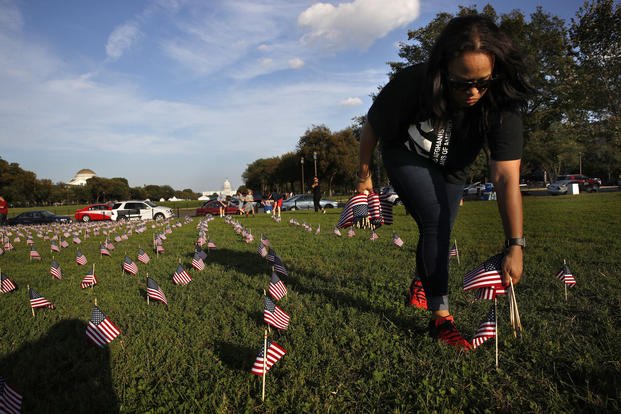Editor's note: This story has been updated to correct the number of active-duty Army suicides.
Army leaders are pleading with the rank and file to be more attuned to signs, or so-called "red flags," of impending mental health breakdowns among fellow soldiers that could lead to suicide attempts.
It's the latest thinking by the service as it faces a crisis of soldiers taking their own lives, with little evidence years of previous efforts are having an effect. Suicides rose by 15% in 2020 within the U.S. military, according to a report released by the Pentagon in October that Defense Secretary Lloyd Austin described as "troubling."
The bulk of suicides are tied to poor finances or failed relationships, so checking for warning signs could mean staying connected to a soldier's family life, or making sure they're paying their bills on time, Sergeant Major of the Army Michael Grinston said Tuesday during the annual Association of the United States Army conference.
"We have to go as far upstream as we can," Grinston said. "We have to recognize someone's struggling with something and get them the help they need."
The active-duty Army saw 175 suicides in 2020, a rate of 36.4 per 100,000, up from 30.7 per 100,000 in 2019. The Army Reserve saw 42, and the Army National Guard had 103.
Read Next: Navy Recovers Remains of 5 Sailors Killed in Helicopter Crash Off San Diego
Grinston, the top enlisted leader for the service, told reporters that suicide prevention has mostly been reactionary and often comes too late.
Instead of the force introducing yet another prevention program or mandatory training, he said, the focus should be on frequently checking in with soldiers and identifying life struggles early.
The idea is to catch life issues early, so they don't have a chance to snowball, according to Grinston.
The effort also needs to go beyond behavioral health, he said. The Army approach should involve general quality-of-life upgrades, and setting soldiers up to make better financial decisions and be better partners in relationships.
Money problems often are a factor in suicide attempts, so financial literacy courses are being added to noncommissioned officer academies for all ranks. Grinston noted that the 2nd Infantry Division in South Korea launched life skills courses, such as how to handle a break up, for newly arriving soldiers.
The National Guard and Reserve face their own unique challenges with suicide.
"Last week, we had two suicides, and possibly more," Command Sergeant Major John Sampa, the top enlisted leader for the Army National Guard, told Military.com in an interview. "Some other deaths are still being investigated."
Sampa said it's important for Guard leaders to be aware of soldiers' personal lives and be able to intervene at the first sign of trouble -- most notably a slipping financial status. But Guard leaders may struggle to stay connected to soldiers who aren't on active duty, he said.
"As Guard leaders, we don't see our soldiers all the time, and for us to identify those soldiers who really need help is hard," Sampa said. "They can clearly mask what's going on sometimes."
Access to resources such as mental health providers can be confusing for those troops, who serve two to four days a month on average and don't live on a base that might have those resources.
Guardsmen also are not entitled to free health care, which Gen. Daniel Hokanson, the chief of the National Guard Bureau, has been lobbying Congress to change.
Command Sergeant Major Andrew Lombardo, the top enlisted leader for the Army Reserve, told reporters Tuesday that commanders have started bringing soldiers on duty to help a fellow service member in crisis get behavioral health care and other support. Putting a soldier on payroll can make it easier to take off civilian work to respond.
"That's the immediate action we're taking now," Lombardo said. "Commands can make that decision to save a life."
A Brown University study published in June found the number of troops and veterans who have died from suicide over the past 20 years -- 30,177 in total -- is more than four times the number killed in the Iraq and Afghanistan wars.
The Army knows who is commiting suicide, James Helis, director of the Army Resilience Directorate, told reporters at the Army conference Monday.
"These are typically soldiers that are between E-3 and E-6, in their 20s, combat arms, male and have access to privately owned firearms," Helis said.
The Defense Department's recent annual report found that troops who commit suicide often are in struggling relationships or have troubled finances and disciplinary issues.
But Helis said there are a lot of unanswered questions the Army is still studying, such as why troops in combat arms are especially vulnerable.
While post-traumatic stress disorder from overseas deployments is a serious concern in the force, mental trauma from time in combat factors in a minority of suicides. Helis said the bulk of suicides were among soldiers who never deployed to a combat zone.
"Is there something we're not seeing that can help us focus our prevention efforts?" he asked. "We expect to have some answers to that next calendar year."
-- Steve Beynon can be reached at Steve.Beynon@military.com. Follow him on Twitter @StevenBeynon.
Related: Since 9/11, Suicide Has Claimed Four Times More Military Lives Than Combat















